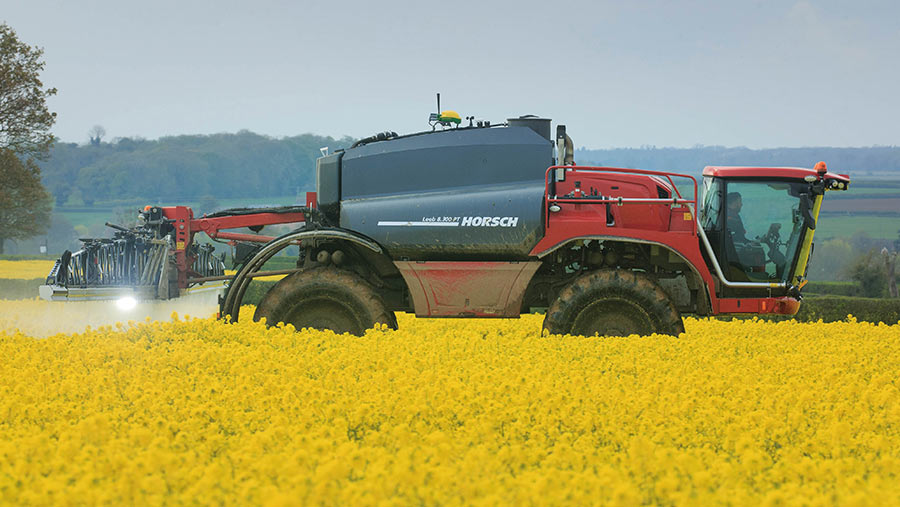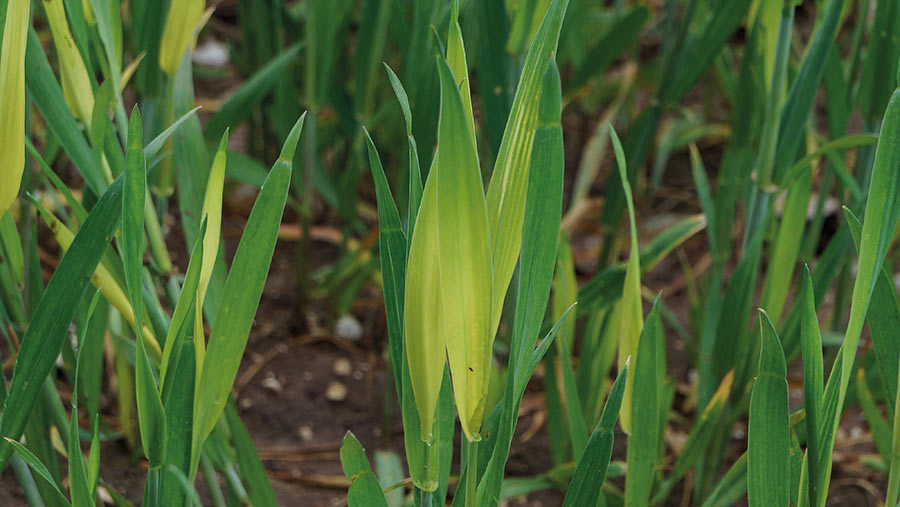Crop Watch: Sprayers dodging showers and maize drilling horror
 © Tim Scrivener
© Tim Scrivener The wait for more settled conditions continues, with the scarcity of spray days forcing growers to reduce the number of passes through crops. One challenge to emerge this spring is that the slower-release of nitrogen from treated-urea fertilisers has hindered efforts to preserve tillers in the north.
Elsewhere, OSR is about two weeks behind normal and maize drilling is proving to be a horror show in the South West, with very little in the ground.
North
Conor Campbell
Hutchinsons (Northumberland)
One month on and conditions continue to be a challenge for all. It’s how I imagine a budget Rocky sequel would look – scrappy.
It really has been a case of seizing any opportunity to keep the jobs moving. Cold, wet soils and a big move to urea has caused some challenges with maintaining tillers and getting crops away throughout April.
See also: How technology lets crops turn pollution into fertiliser
I fear that inhibited products will cause even more headaches in seasons to come, as these are even slower to become available. Bear this in mind when the new season prices come out in a couple of months’ time.
On the whole, wheat crops around the county look well and full of potential. T1 applications are on in most cases, except for later sown wheats which haven’t raced through the growth stages – definitely a saving grace.
Septoria threat
Disease pressure remains high with more than 20 rainfall events in April. Septoria is prevalent in the base of the crop and needs a robust T1 fungicide to keep it there.
Yellow rust is also kicking around, even in some resistant varieties, so some coverage at T1 was a prudent approach.
Winter barleys have motored on with awns soon to be making an appearance. These have perhaps suffered a little with the weather and delayed nitrogen applications, resulting in a large amount of smaller, secondary tillers.
T1s were applied at a variety of growth stages due to the weather, but have done a good job at keeping disease down in the base of the canopy.
Oilseed rapes are well into flower and mid-flower sprays will be imminent as the odd petal begins to fall. Checking the sclerotinia forecast, we have had a handful of near-misses, but with more favourable temperatures on the forecast, it is time to cover these.
This is also a good time to top up nutrition, as the crop demands increase greatly with pod formation and fill. The addition of a strobilurin at this time can help with green leaf retention.
Drills have been busy the past fortnight and spring crops are beginning to emerge. Spring barleys will need particular encouragement to tiller in order to maximise yield potential and suppress the apical dominance.
West
Stephen Harrison
AICC/Southwest Agronomy (Avon)
With only minimal breaks in the rain, spray operators have worked tirelessly to keep on top of an ever-increasing workload. Multiple amendments to work plans are becoming the new normal as we struggle to keep the number of passes through the crop down.
Wet tramlines, with water standing in wheel marks, means row crop tyres have not yet been fitted. Crop growth stages are no respecters of agronomist and farmer tribulations.
The most advanced wheat crops, especially Extase, now have the flag leaf three quarters emerged, meaning the vitally important leaf one spray is now imminent. In many cases the final leaf three spray was applied only seven to 10 days previously. Leaf emergence is the driver of this decision, not calendar date or days elapsed.
Lush growth driven by ample moisture has resulted in more ethephon-based plant growth regulators (PGRs) being employed at a targeted leaf three emergence, which has been frequently delayed by the weather. I was concerned that if we left these treatments until growth stage 39 and rain caused further delays, we would pass the latest growth stage.
The only sensible approach in terms of disease control is to use the strongest materials on the flag leaf, which narrows it down to only two actives: mefentrifluconazole and fenpicoxamid. It looks like our earlier treatments have kept rust at bay. The other issue we see in a dry spring – stress induced mildew – has not materialised.
Fat hen surge
The wet weather has caused a late flush of broad-leaved weeds which will require attention, particularly fat hen.
Winter barley is awaiting its final fungicide of a three-spray programme, an ear-emerged treatment of prothioconazole and pyraclostrobin.
Maize drilling is proving an utter horror show. Little has been completed. There is still time for a good crop, but later drillings often result in a later harvest date with knock-on effects for the following crop.
In a spring which never stops throwing up problems, the consequences can continue to haunt us.
South
Iain Richards
Agrii (Oxfordshire)
After two relatively dry springs in a row, it’s easy to forget how much pressure septoria can put on the system.
With 2012 firmly fixed in the memory, though, we know timeliness will be everything this season. So, alongside prioritising our highest-risk wheats, we’re making sure we don’t miss any spraying opportunity, however slender.
In terms of priority-setting, 2012 taught us that drilling date is far more important than genetics when the septoria going gets tough.
All but our latest-drilled wheats received folpet at T1 with some pretty weighty mixes of SDHIs, azoles and spiroxamine. This may have added £15/ha to the bill, but it’s a small price to pay in a total crop cost of more than £1,500; especially given the 4t/ha responses to decent fungicide programmes we saw in 2012.
The latest septoria chemistry will be earning its keep for its curative value. The fact that today’s fungicide formulations can be rainfast in an hour (on dry leaves) is another advantage. Even so, it looks like we’ll need to take a few chances between showers to make sure our T2s are as timely as they need to be.
The cold-delayed start to our T0s and just enough late-April spray windows meant almost all our T1s went on after no more than a three-week gap. And, with growth picking up as we get some real warmth, we should have a good target for our flag leaf sprays before the next three-week interval is up.
These will be as curative as we can make them, with sufficient emphasis on rust and stem-based disease activity too. While rust infections have yet to become significant, they can emerge rapidly with shifts in the weather.
At the same time, there’s plenty of stem browning evident, and all three of this season’s most widely-grown varieties have eyespot resistance scores of less than 4.
Growth regulation
Our pretty robust PGR programmes, including split applications of trinexapac at T0 and T1, have continued to pay dividends. And thick crops growing especially rapidly in plenty of moisture mean we may well be including the wide-application window chlormequat plus ethephon at T2 on fertile or manured ground.
With some crops only just coming into full flower, our OSR is about two weeks behind where it usually is, so we’re only now starting in on the sclerotinia sprays.
Yellow bud-applied Architect (mepiquat chloride + prohexadione-calcium + pyraclostrobin) has done a good job promoting side branching as well as keeping light leaf spot in check.
Providing that flowering proves relatively short as well as late, we’ll be following this up with single sclerotinia spray in most cases.
As we are easily finding the threshold level of one seed weevil/plant in a number of crops, we will be including the pyrethroid Mavrik (tau-fluvalinate) wherever necessary.
Our February-drilled barleys continue to look promising, and even our delayed April drillings are coming through well now. All the peas are in too, leaving only the maize still to be drilled.

Yellowing in wheat indicating sulphur deficiency © Blackthorn Arable
East
Becky Finbow
Agrovista (Norfolk/Suffolk)
Looking at the forecast while trying to plan, it looks like the weather is still not being our friend, with an unsettled week on the horizon, making travelling difficult on heavy land.
With T1 applications now complete on wheat crops, it is time to think about our flag leaf sprays. The wet weather has increased septoria symptoms, particularly in varieties such as Skyscraper and Bairstow, and where disease pressure has been too high, a T1.5 has been applied. Key actives such as Inatreq (fenpicoxamid) and Revysol (mefentrifluconazole) will feature in my T2 programme.
Barley awns seem to have appeared overnight out the top of crops. As barley crops have grown quickly with high disease pressure, T2 fungicides are more important than ever.
Traditionally, T2 fungicide is less important on a barley crop, but rhynchosporium is evident in a lot of crops and it is only a matter of time before ramularia creeps in too.
Including folpet alongside prothioconazole and an SDHI has been proven to help suppress the diseases, but this year rates are going to have to be kept high.
Disease levels are high in winter bean crops too, with a lot of crops starting to flower. Crop height is definitely shorter than in previous years – crops as well as humans require some sunshine.
Now that flowering has started in most bean crops, a protectant fungicide is being applied containing prothioconazole and benzovindiflupyr with some vital nutrition to help keep the plants healthy.
Sulphur deficiency
Where farmers struggled to get hold of ammonium sulphate fertilisers earlier in the season, or where cost was an issue, nitrogen has been applied alone. Sulphur is vital in the uptake of nitrogen – without it crops can become yellow and stunted.
Sulphur deficiency has become more apparent this year due to the wet conditions and the element being highly leachable. Liquid sulphur has been mixed with a lot of T1 and will continue to be applied into T2 to help the crops that may be suffering.
Sugar beets crops are only just starting to emerge in some very good seed-beds across East Anglia. Unfortunately the skylarks have found them, and their damage is clear.

